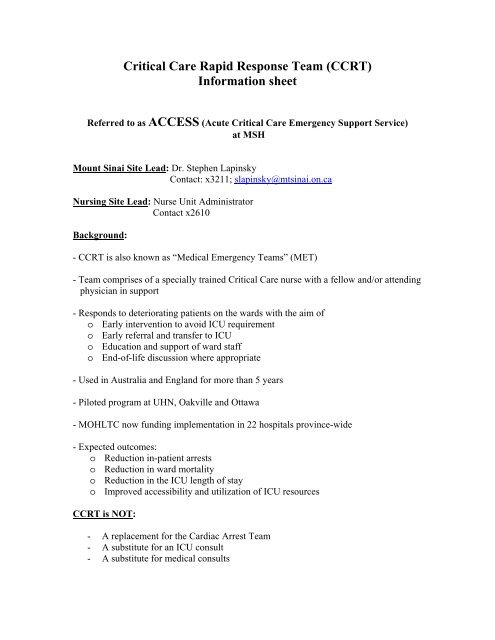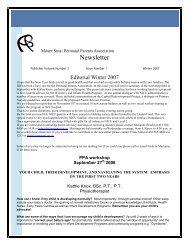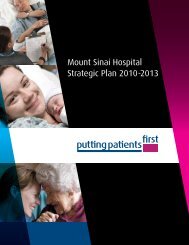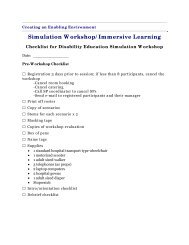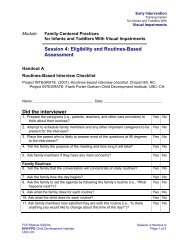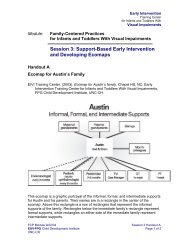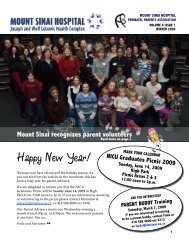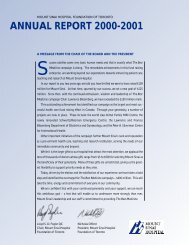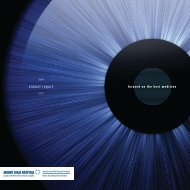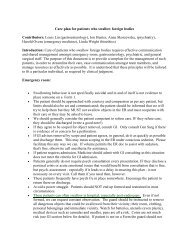Critical Care Rapid Response Team (CCRT) - Mount Sinai Hospital
Critical Care Rapid Response Team (CCRT) - Mount Sinai Hospital
Critical Care Rapid Response Team (CCRT) - Mount Sinai Hospital
Create successful ePaper yourself
Turn your PDF publications into a flip-book with our unique Google optimized e-Paper software.
<strong>Critical</strong> <strong>Care</strong> <strong>Rapid</strong> <strong>Response</strong> <strong>Team</strong> (<strong>CCRT</strong>)Information sheetReferred to as ACCESS (Acute <strong>Critical</strong> <strong>Care</strong> Emergency Support Service)at MSH<strong>Mount</strong> <strong>Sinai</strong> Site Lead: Dr. Stephen LapinskyContact: x3211; slapinsky@mtsinai.on.caNursing Site Lead: Nurse Unit AdministratorContact x2610Background:- <strong>CCRT</strong> is also known as “Medical Emergency <strong>Team</strong>s” (MET)- <strong>Team</strong> comprises of a specially trained <strong>Critical</strong> <strong>Care</strong> nurse with a fellow and/or attendingphysician in support- Responds to deteriorating patients on the wards with the aim ofo Early intervention to avoid ICU requiremento Early referral and transfer to ICUo Education and support of ward staffo End-of-life discussion where appropriate- Used in Australia and England for more than 5 years- Piloted program at UHN, Oakville and Ottawa- MOHLTC now funding implementation in 22 hospitals province-wide- Expected outcomes:o Reduction in-patient arrestso Reduction in ward mortalityo Reduction in the ICU length of stayo Improved accessibility and utilization of ICU resources<strong>CCRT</strong> is NOT:- A replacement for the Cardiac Arrest <strong>Team</strong>- A substitute for an ICU consult- A substitute for medical consults
Calling Criteria: may be called by medical, nursing, respiratory and paramedical staffA- Airway concernsB- Respiratory rate 30, SaO2 50% oxygenC- Systolic BP 200, HR 30D- Decrease LOCO- Other serious concerns, decreased urine outputImplementationNovember 2006- January 2006: Initiation PeriodWeekdays 0800-1600 coverageFebruary 2007 onwards: Full implementation24-hour coverage, 7 days a week
<strong>Mount</strong> <strong>Sinai</strong> <strong>Hospital</strong>Access <strong>Team</strong>‣ Ministry funded initiative in response to Safer Act Now‣ <strong>Team</strong> is made up of ICU nurses, RTs and MDs‣ Consult can be initiated by a RN, RT or <strong>Team</strong> physicians/housestaff‣ When RN/RT call the ACCESS TEAM, they must let the medical teamaware ASAP‣ Consults can be done from urgent situations like:-decreased LOC; hypotension-suspected sepsis-hypoxia-other urgent situations‣ The individual who responds to the call or consults will make a quick assessment,and take care of urgent issues i.e. assess airway, breathing, circulation, readschart, assess labs, DI and confers with the ICU physician on call- decide wherethe most appropriate place for the patient to be- ??? ICU, MSDU, or remain onthe ward‣ Individual will then help organize required care, immediate investigations,immediate treatment, urgent transfer required‣ Attending medical team must always be involved in management decisions‣ <strong>Team</strong> also provides outreach visit to patients who are recently discharged fromthe ICU‣ Part of the role of the ACCESS <strong>Team</strong> is to provide education for the units indealing with urgent situations‣ Remember: Access <strong>Team</strong> does not replace calling CODE BLUE. If a patient ishaving a cardiac or respiratory arrest, or the patient is in severe distress or airwayis compromised, CODE BLUE MUST BE ACTVATED BY THE STAFF
ACCESS Consult1. Primary Assessment• Airway: upper airway obstruction, stridor, secretionsRx: oral/nasal airway, jaw thrust, suction• Breathing: rate & effort, accessory muscles, SpO 2Rx: oxygen, nebulizer, bag-mask• Circulation: cyanosis, HR, BP, perfusionRx: IV access, fluid bolus, atropine, phenylephrine• Triage: Category A, B, C• Is this a code?• Is this an ICU consult? – need for intubation/inotropes2. Further Information• initiate monitoring• underlying disease/admission diagnosis• current episode – what happened?• review current medications• laboratory results and radiology if relevant3. Reassess - diagnoses & interventions to considerRESPIRATORY: COPD/asthma - nebulized CombiventPulmonary edema - LasixConsider CXR, ABGCARDIAC: Hypotension - bolus N/S 500 ml in 30 minBradycardia: atropineTachycardia: Rx hypotension, painChest pain: ASA, nitro, ECGSEPSIS: Fluid bolus, cultureNEURO: Decreased LOC: check glucose, D50W, ABGStroke: urgent Neuro opinion4. Communicate: ACCESS physician, ward team


